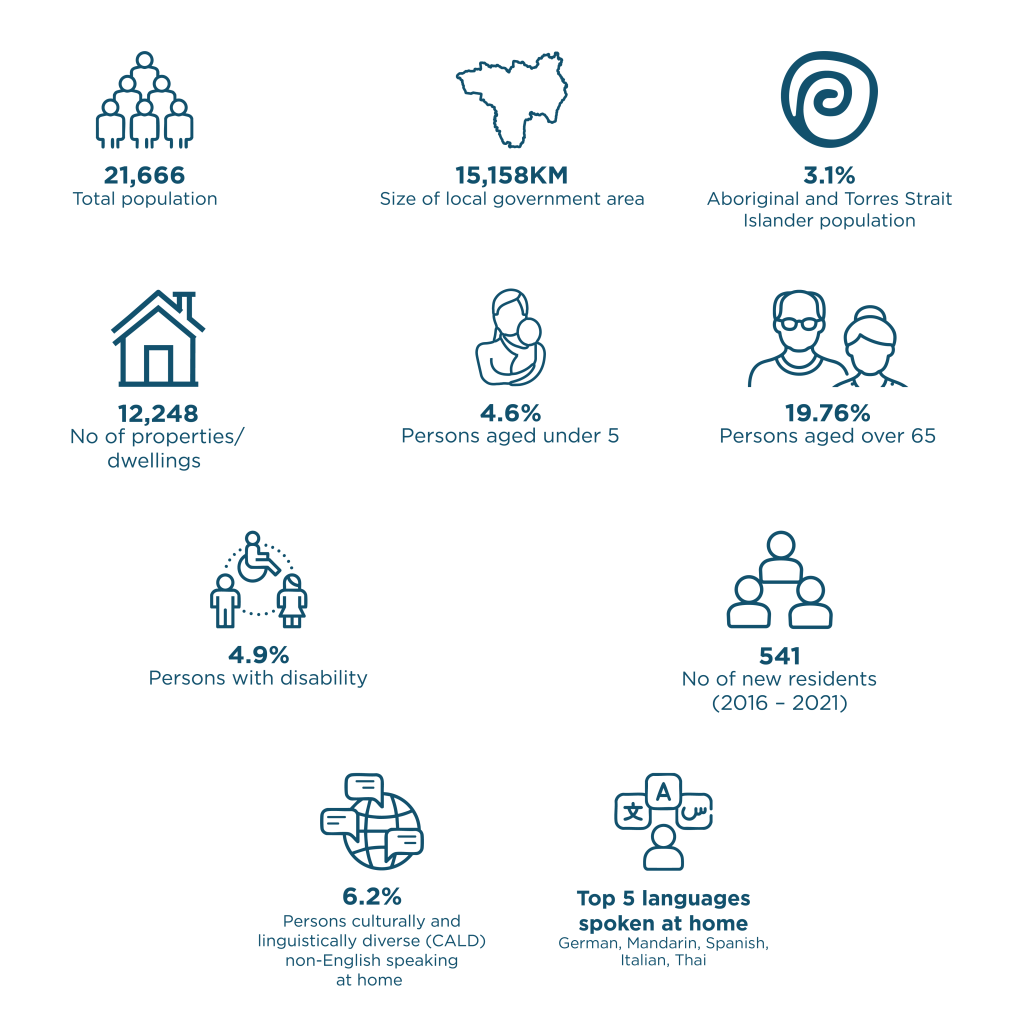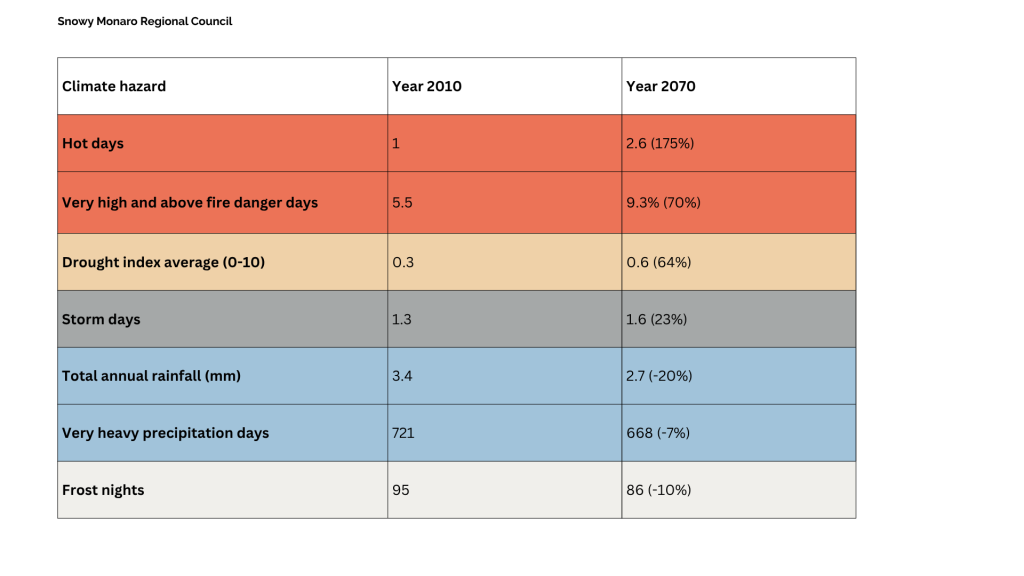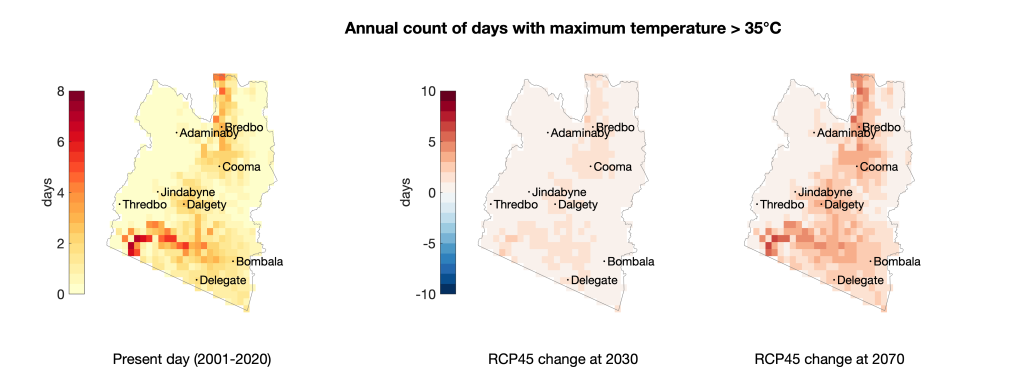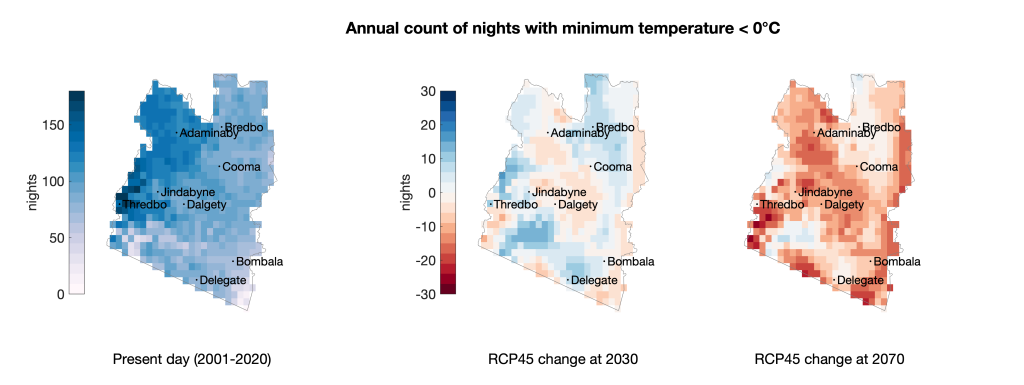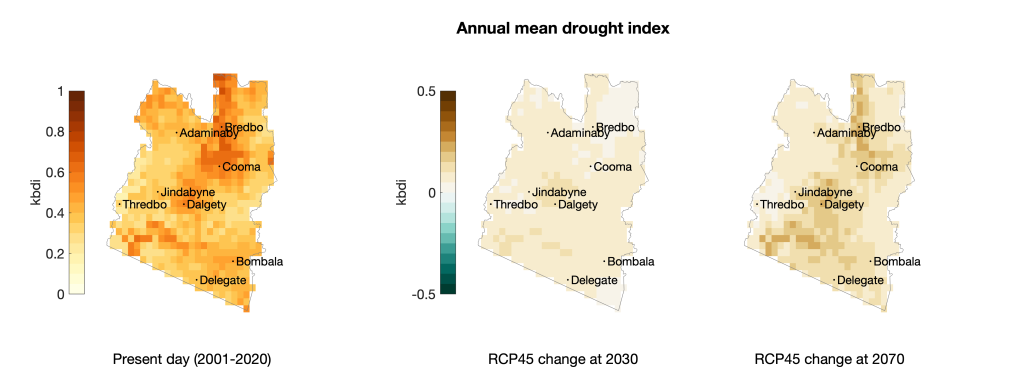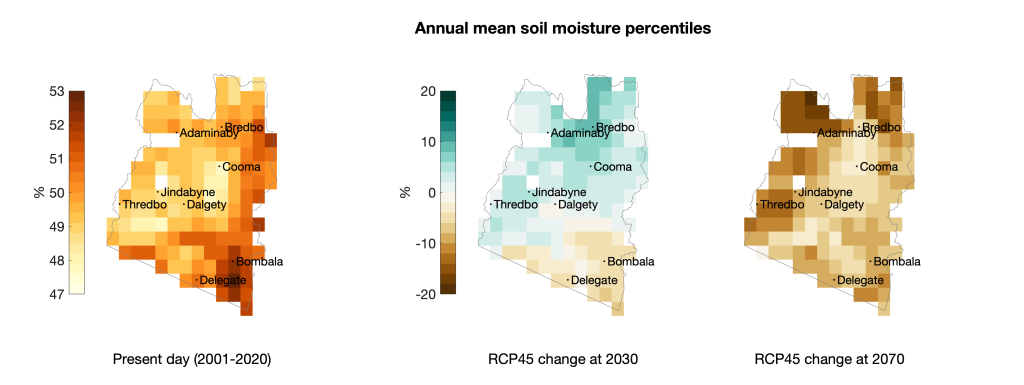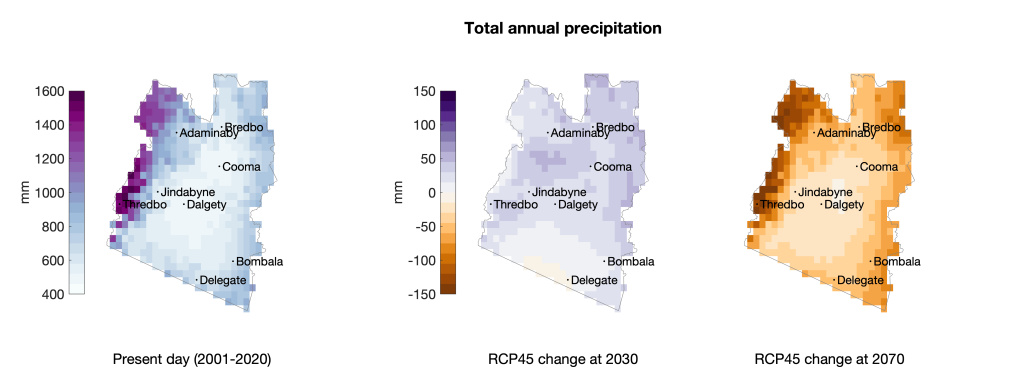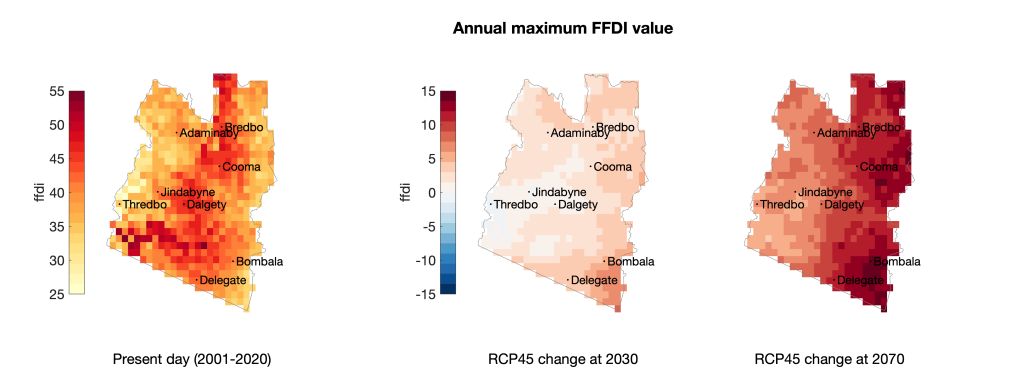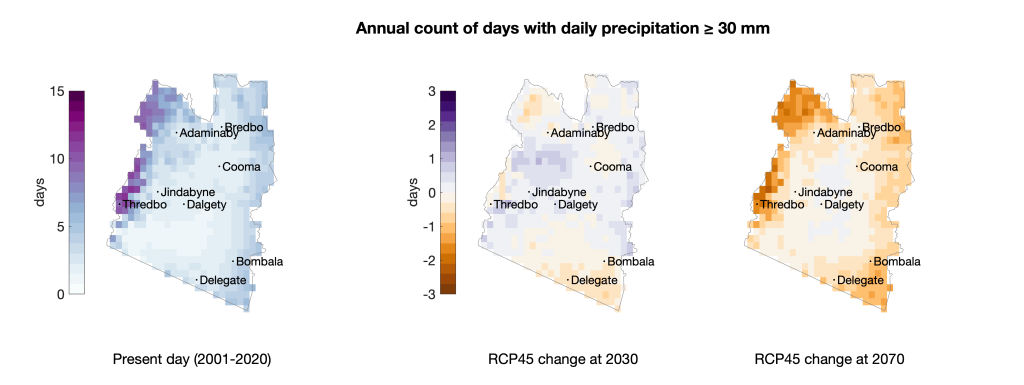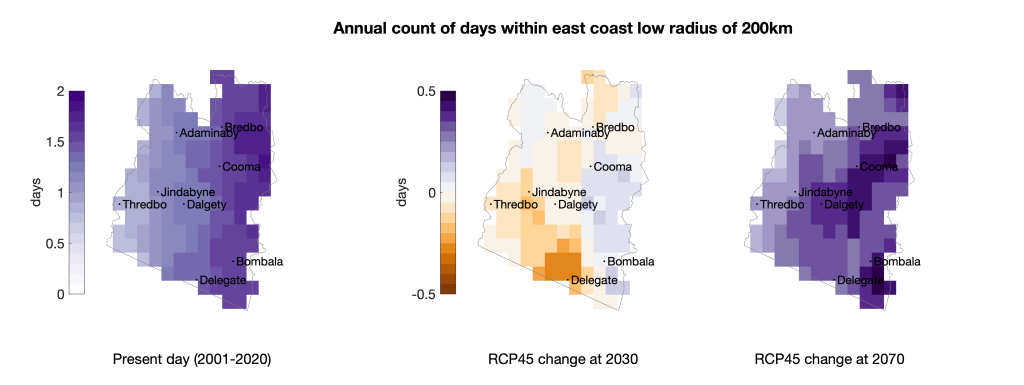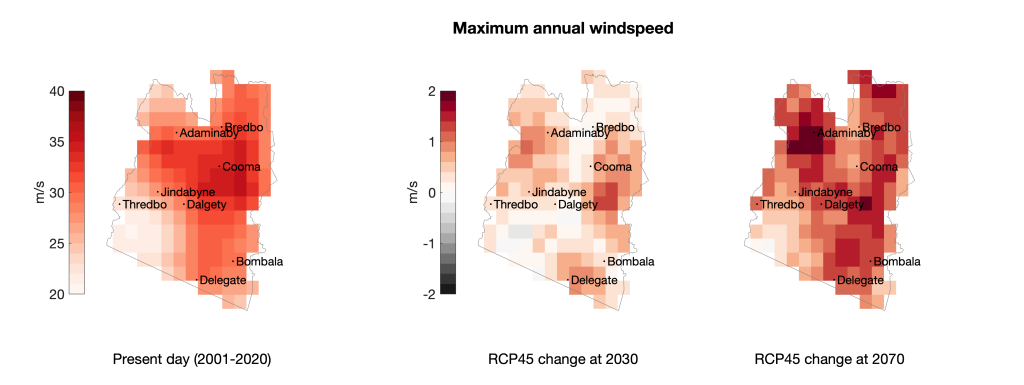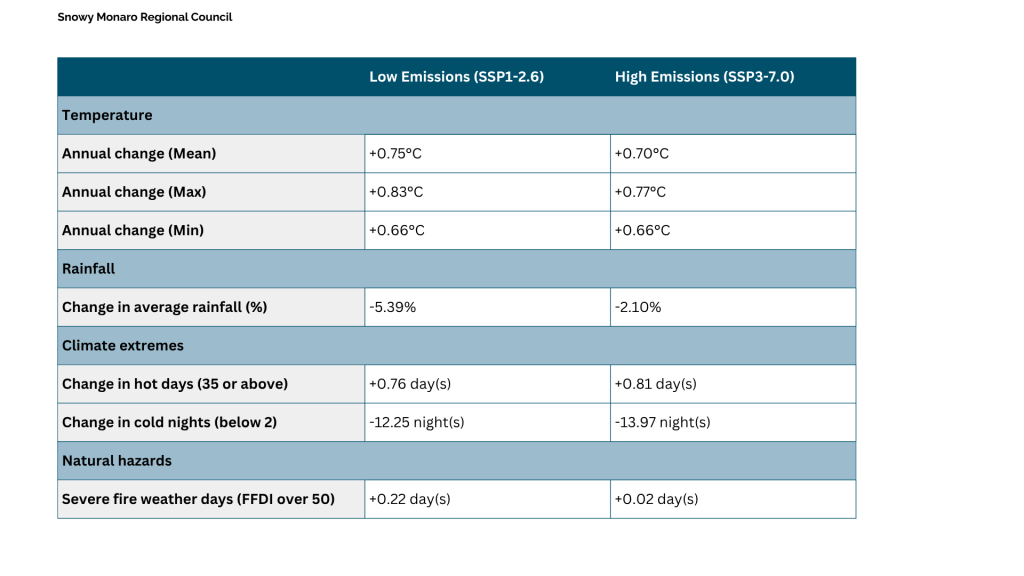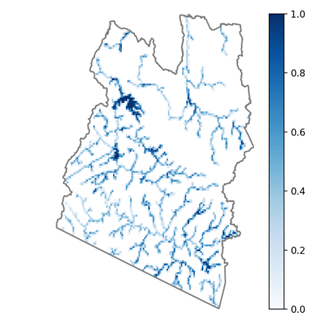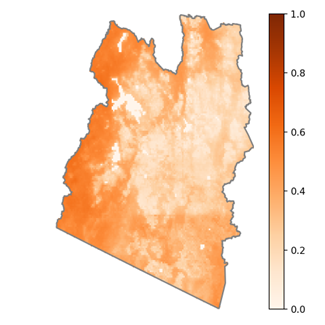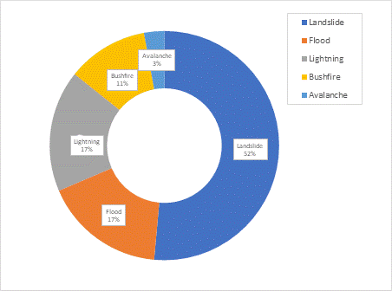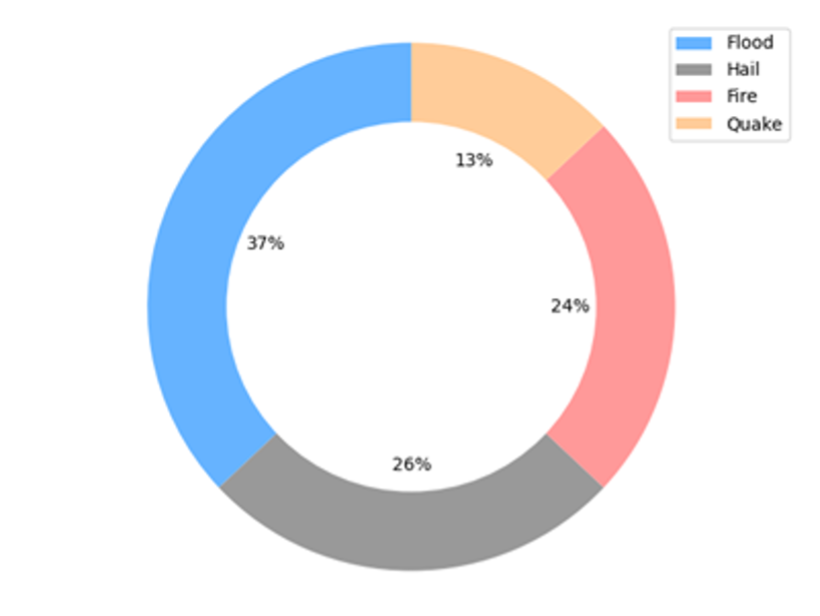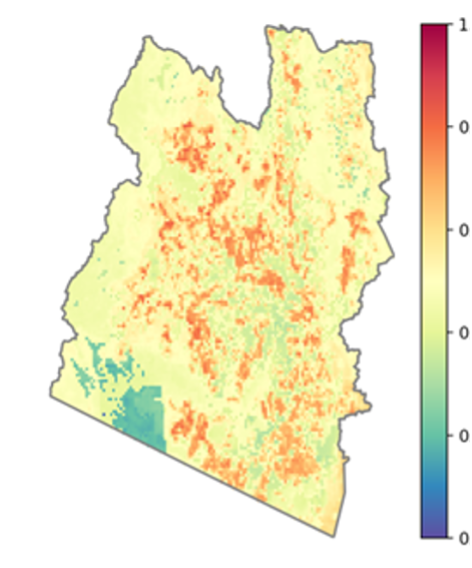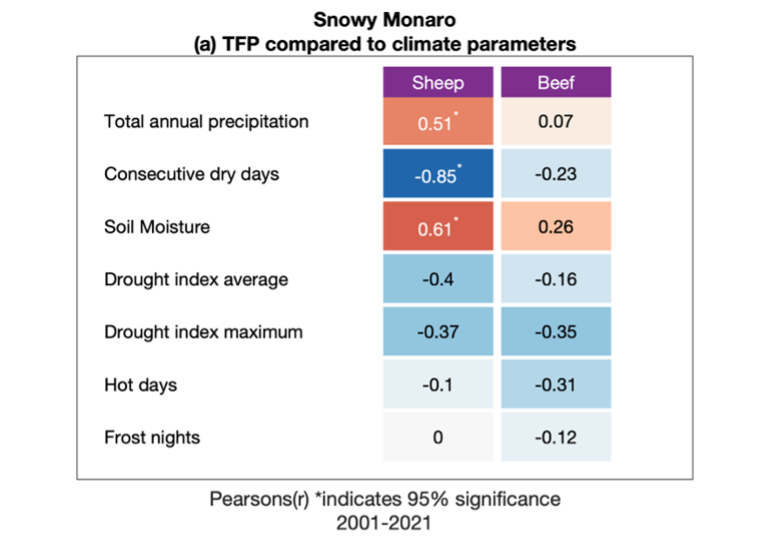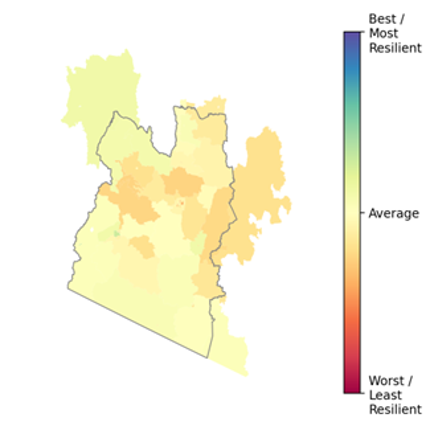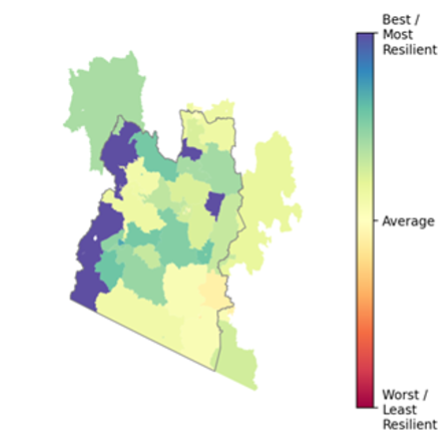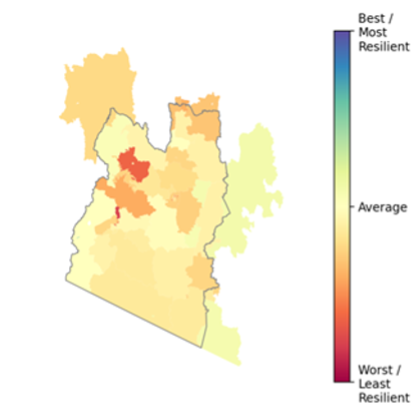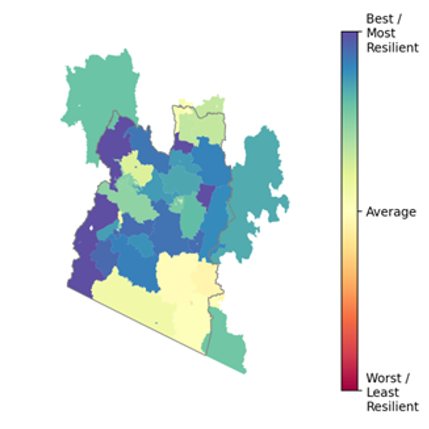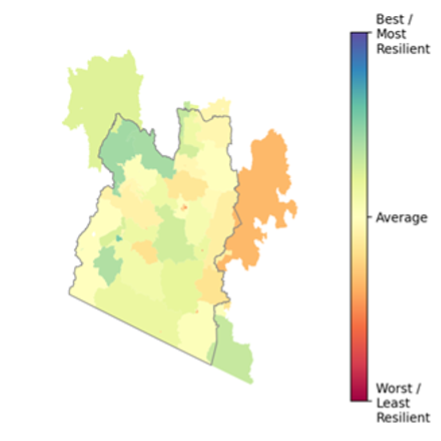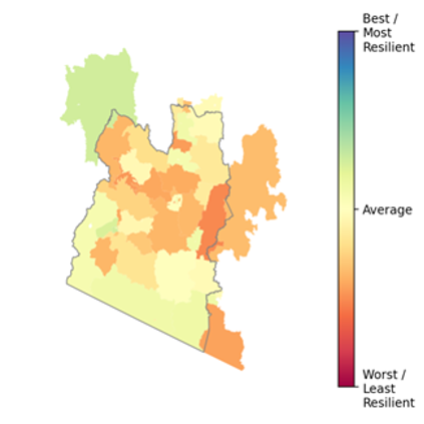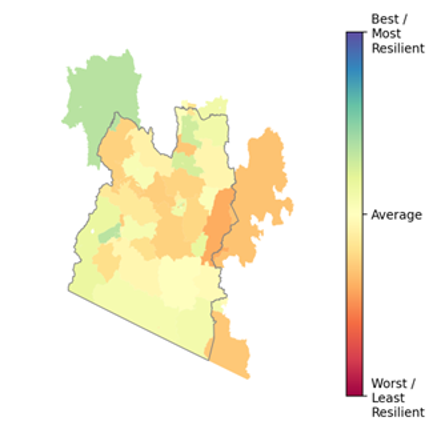Home » Your Local Area » Snowy-Monaro
Local Profile for Snowy Monaro Regional Council
Snowy Monaro Local Government Area
Hazard Exposure Summary
Climate Change Data Summary
Risk Exposure Summary
Reference
The Snowy Monaro Region is located in south-east New South Wales (NSW). It borders the Australian Capital Territory (ACT) and Queanbeyan-Palerang Regional Council to the north, Eurobodalla Shire and Bega Valley Shire in the east, the Victorian border in the south, and the Snowy Valleys Council area in the west. This proximity to the Canberra-Queanbeyan, one of the fastest growing regions, presents opportunities and contributes to development pressure in the area. The Canberra International Airport is a half an hour drive from the northern border. This proximity has enabled the region to capitalise on international tourism opportunities. ¹
The original inhabitants of the Snowy Monaro area were the Ngarigo people, with other groups having connection to the region such as Walgalu in north western parts of the region, Ngunnawal in northeaster parts, and Bidhawal (sometimes spelt Bidwell/Bidawal) in the south around Delegate. Groups from the broader south eastern region, including the NSW Far South Coast and Victorian High Country, traditionally travelled to or through the area as guests of the Ngarigo people for a variety of reasons including trade and social interaction. ²
The Snowy Monaro region has a population of approximately 22,292 people (in 2024) which primarily reside in the main townships of Cooma and Jindabyne, as well as smaller townships and villages at Adaminaby, Berridale, Bombala, Bredbo, Cathcart, Dalgety, and Delegate³. Traversing the region is the Monaro Highway which provides a direct connection to Canberra and the Snowy Mountains Highway which links into the nationally renowned Kosciuszko National Park.
The Snowy Monaro region is predominately rural land that is largely used for agriculture and timber production. Tourism is an important industry to the region with several ski resorts located in the area, national parks, nature reserves, state forests and trout fishing being a major attraction. ⁴
Socio-demographic profile
In 2024, the estimated residential population for Snowy Monaro Council was 22,292 people. ⁵
In 2021, based on the Australian Bureau of Statistics (ABS) 2021 census data, the LGA consisted of:
- LGA size – 15,158 square kilometres; ⁶
- Population – 21,666; ⁷
- Aboriginal and Torres Strait Islander population – 3.1% (687 persons); ⁸
- No of properties/dwellings – 12,248; ⁹
- Persons aged under 5 – 4.6% (1,005 persons); 10
- Persons aged over 65 – 19.76% (4,280 persons); 11
- Persons with disability – 4.9% (1,055 persons); 12
- No of new residents from overseas (2016 – 2021) – 541; 13
- Persons culturally and linguistically diverse (CALD) / non English speaking at home – 6.2% (1,343 persons); and 14
- Top 5 languages spoken at home are German, Mandarin, Spanish, Italian, Thai. 15
Economic profile
As of 2021, agricultural productivity in the Snowy Monaro Region was valued at $173 million with livestock slaughtered (sheep and cattle) accounting for approximately $85 million (62%) of the total agricultural productivity. This was followed by livestock products, mostly wool, at 23%. 16
The top three industries employing local workers in the Snowy Monaro Region in 2022/23: 17
- Accomodation and Food Services (18.8%);
- Construction (12.5%); and
- Retail Trade (9%).
For Snowy Monaro Council in 2022/23 financial year:
- Mining had the highest productivity by industry, generating $1,690,075 per worker; 18
- The Gross Regional Product (GRP) was $1.91 billion in the year ending June 2023 (growing 7.0% since the previous year); and 19
- The total tourism sales in Snowy Monaro Regional Council area was $676.3m (the total value added was $334.4 million). 20
In addition, as of July 2022, the Snowy Mountains Special Activation Precinct (SAP) Master Plan was finalised, which outlines a vision for the area as a year round tourist destination
Environmental profile
The Snowy Monaro Region is characterised by rolling plains and rugged mountain ranges. The LGA has a varied landscape ranging from alpine mountains in the western area, dry open grasslands dominate the eastern side, and agricultural lands and forestry comprise much of the southern area. The basalt soils of Monaro have contributed to productivity of the agricultural land. 21 The main land use in the region is grazing native vegetation, followed by nature conservation, and forestry. The area encompasses the bulk of Snowy Hydro Limited, which generates hydroelectric power to the NSW and Victorian power grids.
Tourism is the most significant sector for the LGA’s local economy. The LGA includes various nature based economic assets, including Mt Kosciuszko, (Australia’s highest mountain) and national parks such as Deua, Gourock, South East Forests, Tallaganda, and Wadbilliga National Parks. Both the Murrumbigee and Snowy Rivers, two of Australia’s most iconic rivers, have their headwaters in the alpine areas before traversing through the region. These rivers are harnessed to power the Snowy Mountains Scheme and are used to irrigate farmlands in the surrounding regions. 22
The Snowy Monaro Region consists of several service towns, including Cooma (including Polo Flat, which is the largest township in the region with a population of approximately 6,700 in 2021) 23, Jindabyne (including Tyrolean Village and East Jindabyne), Bombala, Berridale and Michelago. 24 There are also a number of Villages (Adaminaby, Bredbo, Dalgety and Delegate), and Alpine Villages / localities (including Blue Cow, Guthega, Kiandra, Perisher, Smiggin Holes and Thredbo). 25
Traversing the region is the Monaro Highway which provides a direct connection to Canberra and the Snowy Mountains Highway which links into the nationally renowned Kosciuszko National Park.
Governance profile
he Snowy Monaro Region borders the Australian Capital Territory (ACT) and Queanbeyan-Palerang Regional Council to the north, Eurobodalla Shire and Bega Valley Shire in the east, the Victorian border in the south, and the Snowy Valleys Council area in the west.
The traditional owners of the Snowy Monaro Regional Council area are the Ngarigo people. The Snowy Monaro Regional Council area is named after the Snowy River and Monaro, which is an Aboriginal word meaning “treeless plains”. 26 There are also other groups who have a connection to the wider Snowy Monaro Region such as Walgalu in north-western parts of the region, Ngunnawal in north-eastern parts, and Bidhawal in the south around Delegate. 27
The Council has eleven elected Councillors for four-year term. The Mayor is elected by the Councillors and is recognised as the civic leader of the community. 28
Hazard Exposure Summary
The Snowy Monaro Region is vulnerable to a wide range of natural hazards , making it essential to understand the nature and extent of exposure to people, buildings, infrastructure, services, or natural resources to effectively assess and address associated risks.
Exposure can be seen in various forms:
- Relative exposure is a function of hazard, describing the frequency and magnitude of natural hazard events and capturing the compounding effect of multiple hazards (fire and flood for this analysis). Where a community is subject to both fire and flood, it is potentially less resilient than one exposed to a single hazard of the same frequency and magnitude;
- The physical exposure of a community is determined such that the quantum of exposed people, buildings, essential facilities, industry, and agriculture can be evaluated. The physical vulnerability of exposed elements is also important, such as the age and construction type of buildings (for example, buildings with raised floors are more resilient to flood as they provide greater protection to the occupants and their belongings, resulting in less loss of life and property); and
- Social vulnerability is determined by examining socio-economic and demographic factors that may exacerbate or ameliorate the effects of an external threat to a person’s life, livelihood, or assets. Examples of these types of indicators include age, occupation, health status, income and education.
The Resilience Blueprint identified the following hazards as relevant hazardous events for the southeast NSW region. In 2024 the State Disaster Mitigation Plan (SDMP) was implemented and any additional hazards or information regarding exposure of hazard in the region has been included below:
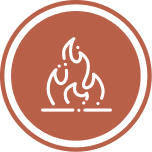 Fire (bushfire and grassfire)
Fire (bushfire and grassfire)
- Bush and grass fires are known to affect the LGA, with much of the rural areas identified as being within very high / high risk land;
- The bush fire season generally runs from October to March. In some years, good summer rains, drier than normal autumn conditions, severe winter frosts and gale force winds have created a further fire danger period throughout the winter months; 29
- The Snowy Monaro Region experiences, on average, 54 bushfires per year, of which two can be considered major fires; 30
- Based on the potential event probability, as provided by Risk Frontiers, annual average loss of residential, commercial and industrial buildings from flood in the LGA is 24 per cent under a RCP 4.5 scenario. This accounts for a moderate probability of occurring but a high financial cost consequence of bushfire activity;
- There have been a number of significant bushfire events in the Snowy Monaro Region. In the summer of 2019/2020 significantly impacted the Snowy Monaro Region. Approximately 14% of the LGA was directly burnt by the fires (approximately 15,000 square kilometres of land), destroying 100 properties and 45% of all forestry land in the LGA. The fires also had flow on effects to tourism, effectively destroying the Selwyn Snowfields. 31 The 2019/20 bushfire season has shown the Snowy Monaro Region’s susceptibility to bushfire.
Actions taken or proposed:
- Council’s Local Strategic Planning Statement (LSPS) considered risks associated with bushfires as a major issue affecting much of the Snowy Monaro Region. Planning Priority 11 of the LSPS is to “foster resilient, enduring and safe local communities using land use planning controls which address local and regional natural hazards.” It includes several actions for Council to achieve this priority; 32
- Council has prepared the Draft Settlements Strategy, which provides a strategic land use planning direction for all towns in villages in the LGA, including identifying specific locations where future development intensification be avoided due to bushfire risk.
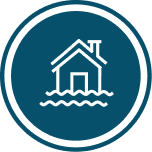 Flooding
Flooding
- There are urban areas in the LGA that have flood prone land, these being Berridale, Bredbo, Cooma, Michelago, and Bombala. Various localities in certain locations are also deemed to be susceptible to flooding in major events;
- There are seven dams within the Snowy-Monaro Region. These include Tantangra, Cowarra Creek Tailings, Eucambyne, Guthega, Island Bend, Jindabyne and Delegate Flood Detention Basin; 33
- Flood risk at Berridale is present from Myack Creek and Colamatong Creek where high creek flows overtops the channel banks and spreads over roads and property. Coolamatong Creek, which runs through the town, has minimal channel capacity and spreads onto main roads including Jindabyne Road and Myack Street, as well as low-lying properties. Coolamatong Creek tends to cause less property flooding but can cause hazardous road flooding at several road crossings. Kosciuszko Road, which is a main arterial road providing access to Berridale and the NSW ski resorts, can also be flooded by Wullwye Creek/Myack Creek around 2km north-east of town; 34
- Bredbo has relatively little flood affectation in smaller flood events, but in those events of 5% AEP and larger, the Bredbo River can cause widespread inundation of roads and properties in the southern portion of the town. There is a second, smaller watercourse also traverses through the town that can cause flooding at several locations. Flood risk is also present from the Murrumbidgee River; 35
- Cooma has significant flood affectation along sections of Cooma Creek and Cooma Back Creek, particularly in flood events of 10% AEP (annual exceedance probability) and larger where the parts of the levee are overtopped. On Cooma Creek, property and road flooding occur when parts of the levee are overtopped, with the potential for severe flooding particularly around Sharp Street and Commissioner Street. Cooma Back Creek also has the potential to flood roads and properties, with a flooding hotspot in the section of creek of north of Sharp Street which is subject to high risk flooding. There is a third creek flooding hotspot near the confluence of the two creeks, near Mulach Street. In addition to creek flooding, flooding occurs in the Polo Flat industrial area, and in some residential areas due to overland flow. 36 Historically, Cooma has been affected by a number of flood events, including in 1991 where 43 residences and 10 businesses were damaged. In 1956, almost 60mm of rain fell in 90 minutes, which quickly inundated much of the town.
- Michelago has relatively little flood affectation compared to other towns, with most areas of Michelago Creek’s floodplain away from dwellings and roads. While in very rare events (eg. 0.2% AEP) very few dwellings are directly affected by creek flooding, there is potential for severe inundation across the town in the Probable Maximum Flood (PMF); 37
- Bombala is known to be affected by flood and Council has sought to restrict development in low lying areas potentially vulnerable to flooding. Bombala has experienced major floods in the past, most notably in 1971, 1952 and 1983; and 38
- Based on the potential event probability, as provided by Risk Frontiers, annual average loss of residential, commercial and industrial buildings from flood in the LGA is 37 per cent under a RCP 4.5 scenario. This accounts for a moderate probability occurring and a high financial cost consequence of flood activity.
Actions taken or proposed:
- Council’s Local Strategic Planning Statement (LSPS) considered risks associated with floods as a major issue affecting much of the Snowy Monaro Region. Planning Priority 11 of the LSPS is to “foster resilient, enduring and safe local communities using land use planning controls which address local and regional natural hazards.” These include: 39
- Action 11.2 is that “Council will implement flood planning controls based on flood risk management plans for Berridale, Bombala, Bredbo, Cooma and Michelago” as a short/medium -term action; and
- Action 11.4 is that “Council will work with Snowy Hydro to use flood data to inform planning decisions around Lake Jindabyne and Eucumbene.”
- Council has prepared the Draft Settlements Strategy, which provides a strategic land use planning direction for all towns in villages in the LGA, including identifying specific where future development intensification be avoided due to flooding risk; and
- Council have prepared the Floodplain Risk Management Studies and Plans Report, November 2020, which includes various strategies and actions to better respond to the flood risk present (particularly in Cooma).
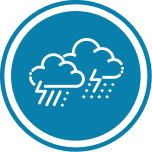 Severe storm
Severe storm
- Severe storms in NSW are often associated with East Coast Lows (ECL). ECL events are extreme weather systems that occur in South-East Australia, bringing extreme winds, rain, hail and lightening;
- The maximum annual windspeed is projected to increase across the LGA;
- Severe storms (with accompanying lightening, hail, wind snow and / or rain causing severe damage (including tornado) is identified as a likely natural hazard event in the region with moderate consequence in Council’s EMPLAN; and
- Based on the potential event probability, as provided by Risk Frontiers, annual average loss of residential, commercial and industrial buildings from hail damage associated with a storm in the LGA is 26 per cent under a RCP 4.5 scenario. This accounts for a moderate probability of occurring but a high financial cost consequence of severe storm activity.
Actions taken or proposed:
- The Snowy Monaro Local Emergency Management Committee has prepared the EMPLAN to produce arrangements that provide the basis for managing emergency impacts in the Snowy Monaro Region, including landslides.
 Snow
Snow
- The Snowy Monaro Region is subjected to a number of snow falls each year, with most of these events causing little if any disruption to communities or any of the travelling public; and
- While snowfalls do regularly occur in the higher alpine areas of the Region (where they are well prepared and equipped to address seasonal snow falls and blizzards, even if they are severe), medium to heavy snow falls can occur on the lower elevations accompanied with damaging winds and associated disruptions to the community; 40
- Examples of significant snow falls in the Snowy Monaro Region include: 41
- On 1 July 1987, the Snowy Monaro received heavy snowfalls (the highest since 1949). Areas around Bombala, Nimmitabel and Delegate had between one and two metres of snow, closing roads and bringing down power and telephone lines. The snow remained on the ground for up to two weeks and a million sheep were caught without shelter and food;
- On 17-18 July 2003, snow closed all roads in the Cooma/Bombala/Jindabyne area of the Southern Tablelands; and
- Snowfalls of up to 40 cm were recorded in the Jindabyne area from 8-10 July 2005, isolating towns for several days and cutting power supplies for two days.
Actions taken or proposed:
- The State Emergency Service (SES) has implemented a South Eastern Region Snow Emergency Sub Plan with key strategies and actions.
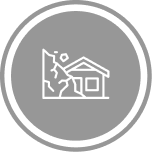 Landslide
Landslide
- Landslide can be triggered by severe weather events (e.g. heavy rainfall) or human activities (vegetation removal, overgrazing, slope modification, etc.); and42
- The probability of landslides in the region are considered rare, but the level of consequence can be high depending on the location. This risk is higher in parts of the LGA with steep topography;
- While landslides are considered a rare occurrence, they do indeed occur. In July 1997, a landslide at the ski resort village of Thredbo occurred resulting in approximately 2,000 cubic metres of rock shifting. As a result, 19 victims were buried in a ski lodged after it was lodged off its foundations. Eighteen bodies were recovered and one survivor was rescued from under debris more than 60 hours later. 43
Actions taken or proposed
- The Snowy Monaro Local Emergency Management Committee has prepared the EMPLAN to produce arrangements that provide the basis for managing emergency impacts in the Snowy Monaro Region, including landslides; and
- Action 11.7 in the Snowy Monaro LSPS identifies that “Council will map landslide risk and include relevant planning controls.”
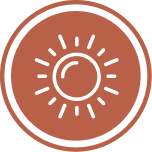 Heatwave
Heatwave
- A heatwave is generally defined as ‘a period of abnormally hot weather lasting over several days’, and can be characterised as three or more days of high maximum and high minimum temperatures that are unusual for that location’; and 44
- The area is climatically diverse and is predominantly cool temperate, with higher elevation areas having greater daily extremes (colder winters and hotter summers). The Snowy Monaro Local Emergency Management Plan (EMPLAN) denoted the risk of heatwaves as being low. 45
Note: The Snowy Monaro Region is not exposed to this hazard, however heatwaves are a hazard for wider South East NSW Region and may have consequential impacts to the Snowy Monaro Region.
Actions taken or proposed:
- The Snowy Monaro Local Emergency Management Committee has prepared the EMPLAN to produce arrangements that provide the basis for managing emergency impacts in the Snowy Monaro Region, including heatwave.
![]() Tsunami
Tsunami
- Tsunami’s can be generated by a number of causes, however, undersea earthquakes are the most likely to generate such an event. Tsunami waves can run up beyond the high tide mark causing significant damage to coastal areas.
Note: The Snowy Monaro Region is not exposed to this hazard, however tsunami’s are a hazard for wider South East NSW Region and may have consequential impacts to the Region.
Actions taken or proposed:
- No actions have been taken or proposed for to address storm and cyclone risks within the Council area.
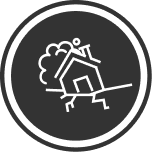 Earthquake
Earthquake
- The Canberra Region sits on a major eastern fault line. The nearest seismic zone is to the north near the township of Gunning. Earthquakes occuring to the north of the Snowy Monaro Region are known to occur on occasion. On 15 February 1998, a magnitude ML 4.2 earthquake occurred in the Brindabella Mountains, near Brindabella Homestead, this earthquake was large enough that it was felt in Cooma; and 46
- Based on the potential event probability, as provided by Risk Frontiers, annual average loss of residential, commercial and industrial buildings from flood in the LGA is 13 per cent under a RCP 4.5 scenario. This accounts for a low probability of occurring but a high financial cost consequence of earthquake activity.
Actions taken or proposed:
- The Snowy Monaro Local Emergency Management Committee has prepared the EMPLAN to produce arrangements that provide the basis for managing emergency impacts in the Snowy Monaro Region, including earthquakes.
Climate Change Data Summary
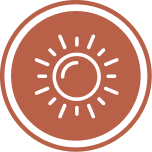
Heatwave – measured by number of days with temperatures greater than 35°C
Heatwaves are a critical climate hazard affecting health, infrastructure, and ecosystems. Heatwave risk can be measured by tracking the number of days per year with maximum temperatures exceeding 35°C. This analysis, undertaken by Risk Frontiers in 2021, drew on 20-year averages from historical climate reanalysis data and future climate model projections under a ‘medium’ emissions scenario, represented by RCP4.5 (see Figure 1 below).
Figure 1 – Frequency of days per year with temperature greater than 35 Celsius Degrees
(Values are 20-year averages for present day climate and change for future climate under the RCP4.5 scenario.)
The data highlights how the frequency and seasonality of high-temperature events are expected to shift over time in the LGA, informing the need for climate adaptation in infrastructure, health, and planning decisions.
Key Findings:
- The magnitude of temperature extremes and frequency of hot days will increase for inland LGAs however, the Snowy Monaro will experience this change less so than the surrounding LGAs;
- largest increases in heatwave and high temperature extremes will be seen during the summer months;
- high temperature extremes will also occur more frequently during spring and autumn; and
- Snowy Monaro will have less frequent cold nights which will become more apparent by 2070 with the frequency of frost nights dropping significantly as seen in Figure 2 below.
Figure 2: Frequency of days per year with temperatures lower than 0 Celsius Degrees
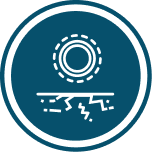
Drought – measured by Keetch-Byram Drought Index, soil moisture and annual precipitation
Drought is a complex hazard influenced by temperature, rainfall, and how water is retained in the landscape. To assess how drought conditions are projected to change in the LGA, this analysis undertaken by Risk Frontiers in 2021 used three key climate indicators:
- Keetch-Byram Drought Index (KBDI) – a widely used index that estimates how dry the landscape is based on temperature and rainfall. It also reflects the flammability of surface fuels and is commonly used for fire management (see Figure 3 below);
- Soil moisture percentiles – a direct measure of how much water is retained in the soil compared to long-term conditions. Soil moisture is essential for agriculture, vegetation health, and ecosystem resilience (see Figure 4 below); and
- Total annual precipitation – tracks overall rainfall trends, which are a key input for drought but must be considered alongside evaporation and temperature to understand drought risk fully (see Figure 5 below).
Figure 3: Annual mean Keetch-Byram Drought Index (KBDI) drought index value normalised on a scale of 0-10, where 10 is the maximum drought possible
(Values are 20-year averages for present day climate and change for future climate under the RCP4.5 scenario)
In summary:
- inland LGAs are more exposed and susceptible to drought. Snowy Monaro is no exception however, the effects will be less than the surrounding LGAs; and
- Under future climate, by 2070 the magnitude of drought will increase across all LGAs.
Figure 4: Annual mean soil moisture percentiles; values are calculated relative to present day climate, hence the 50% values for present day. Low values at 2070 are indicative of a drying landscape.
(Values are 20-year averages for present day climate and change for future climate under the RCP4.5 scenario)
Figure 5: Total annual precipitation in mm per year
(Values are 20-year averages for present day climate and change for future climate under the RCP4.5 scenario)
These indicators are derived from climate model simulations using 20-year averages for present-day and future scenarios under RCP4.5. Together, they provide a fuller picture of both short-term and long-term drought potential, capturing the interplay between rainfall, heat, and water retention in the landscape.
Key Findings:
- By 2070 the magnitude of drought will increase across the Council area as soil moisture declines by 2070, with the greatest impact occurring during the winter and spring; and
- changes in total annual rainfall are less than the projected changes in soil moisture and drought, suggesting that the increase in drought is being driven primarily by increasing temperatures and their effect on evapotranspiration.

Bush and grassfire – measured by the annual maximum Forest Fire Danger Index (FFDI)
Bushfires and grassfires are among the most dangerous and disruptive climate-related hazards in South-East NSW Region. The annual maximum Forest Fire Danger Index (FFDI) is the nationally recognised measure for assessing bushfire danger and is widely used by emergency services to guide fire warnings, restrictions, and preparedness. FFDI is a composite index that incorporates temperature, wind speed, humidity, and recent rainfall to estimate how dangerous fire weather is on a given day.
This analysis undertaken by Risk Frontiers in 2021 used 20-year averages from historical reanalysis data and future climate projections under the RCP4.5 scenario (see Figure 6 below). This indicator helps identify trends in both the severity and seasonal timing of fire weather across the LGA.
Figure 6: Magnitude of bushfire weather severity as represented by the annual maximum FFDI
(Values are 20-year averages for present day climate and change for future climate under the RCP4.5 scenario)
Key Findings:
- the frequency of dangerous bushfire weather days and the magnitude of bushfire weather extremes will increase in the surrounding LGAs;
- the slower rate of increase for Snowy Monaro may be due to the influence of overall lower temperatures at higher elevations; and
- the largest changes for bushfire weather across southeast Australia are expected to be occurring during the spring, with a projected earlier onset of the bushfire season under a warmer climate.

Extreme rainfall and flooding – measured by daily precipitation over 30mm
Flooding poses a significant hazard to infrastructure, communities, and emergency services. This analysis uses the frequency of very heavy rainfall days (daily rainfall greater than 30mm) as an indicator of flood risk. This threshold (i.e., days with more than 30mm of rain often) is a recognised benchmark in climate and hydrological studies to identify rainfall events that can overwhelm stormwater systems, trigger flash flooding, and lead to significant overland flow.
Projections done by Risk Frontiers in 2021 compared 20-year averages for present day conditions with those for 2030 and 2070 under the RCP4.5 scenario (see Figure 7 below). This helps to understand how the intensity of rainfall events changes, which is crucial for flood management, infrastructure design, and emergency planning.
Figure 7: Frequency of very heavy rainfall days (>30mm)
(Values are 20-year averages for present day climate and change for future climate under the RCP4.5 scenario)
Key Findings:
- the primary driver of year-to-year variability in rainfall will continue to be the tropical climate drivers of Indian Ocean Dipole (IOD), El Niño Southern Oscillation (ENSO) and the Inter-decadal Pacific Oscillation (IPO). Projections for Pacific climate are indicating an increase in ENSO amplitude, meaning both El Niño and La Niña events will be stronger;
- extreme rainfall events will produce higher rainfall totals due to the physical relationship between a warmer temperatures and higher atmospheric moisture capacity; and
- higher rainfall totals may lead to higher flood levels during flooding events, but the frequency of these events will not differ significantly from present.

Severe storm, wind and hail
Severe storms, ranging from East Coast Lows to thunderstorms and hail events, pose a recurring hazard to communities and infrastructure. This analysis uses two key indicators to evaluate storm-related risk under a changing climate:
- frequency of East Coast Low (ECL) days – ECLs are among the most damaging storm systems affecting the region, often associated with extreme winds, heavy rainfall, large waves, and coastal erosion. Tracking their frequency is important for understanding long-term storm risks (see Figure 8 below); and
- annual maximum windspeed – is used to assess the strength of storm systems and frontal weather events that can bring down trees, damage infrastructure, and increase fire danger (see Figure 9 below).
Figure 8: Frequency of east coast low days
(Values are 20-year averages for present day climate and change for future climate under the RCP4.5 scenario)
Figure 9 : Annual maximum windspeed (km/hr).
(Values are averaged across each LGA and calculated as 20-year averages for present day climate and change for future climate under the RCP4.5 scenario—windspeeds at individual locations and years will be significantly higher than the averages)
These indicators help assess changes in both the occurrence and severity of damaging weather systems.
Projections done by Risk Frontiers in 2021 were based on 20-year averages comparing present-day conditions with future scenarios for 2050 and 2070 under RCP4.5. This helps identify trends in the intensity and potential impacts of storm systems in the LGA which may influence risk planning, emergency management, and infrastructure resilience.
Key Findings:
- Under present day climate, the Council area is exposed to several types of storms, including east coast lows (ECL), extra-tropical lows, fronts, snowstorms, thunderstorms, and hailstorms;
- ECL are one of the most damaging storm types to impact the Council area. ECL frequency is expected to increase slightly under future climate which is consistent with an expectation of increased large scale interactions between warm and cool air masses as the climate warms;
- storms tend to be more frequent during La Niña events and less frequent during El Niño events. This relationship is not expected to change under a warming climate.
- extratropical lows and associated fronts and thunderstorms can cause significant risk, especially during summertime when they are a primary cause of dangerous bushfire weather; and
- maximum annual windspeed is projected to increase across the Council area, suggesting an increase in the strength of frontal systems, especially in the Kosciuszko area.
NarCLIM 2.0 findings for Snowy Valleys Council
In 2022 NARClim 2.0 climate data was publicly released – this is the most up-to-date regional climate modelling available for NSW and ACT and is used Government planning, assessments, and strategies.
Table 2 below describes the anticipated future climate projections specific to Snowy Valleys Council based on NARCLiM 2.0 RCP4.5 (medium emissions) and RCP8.5 (high emissions) scenarios.
This information can be viewed through can be interactive climate change project map via https://www.climatechange.environment.nsw.gov.au/projections-map
Table 2: Future climate predictions for Snowy Monaro Council
Risk Exposure Summary
Hazards
A hazard is a natural process or occurrence, a source event which has the potential to result in harm or cause loss or damage depending on exposure. The South Eastern Regional Emergency Management Plan has identified the following hazards as having risk of causing loss of life, property, utilities, services and/or the community’s ability to function within its normal capacity:
|
|
|
In 2024, the NSW State Disaster Mitigation Plan identifies these additional 3 hazards having the same risk to life and property: 48
- Coastal hazard (erosion and inundation);
- Storms and cyclones; and
- Tsunami.
Climate modelling helps us to examine the implications for hazard likelihood. The Climate modelling performed by Risk Frontiers as part of the Resilience Blueprint found that Snowy Monaro has:
- low/moderate flood hazard risk with 8.09% of the land within a modelled floodplain. This follows the alpine ranges in the west and stems down to the south, south east boundary (see Figure 10 below); and
- moderate bush and grassfire hazard risk with a modelled annual burning probability of 0.64%. This risk area is largely confined to the environment protection and rural zones (see Figure 11 below).
Figure 10: Snowy Monaro Flood Hazard Index
A dark blue indicates a flood plain, the lighter colour out of it.
The flood hazard index uses a map of modelled flood plains identified by several geographical/geospatial variables including different river types, river stream order, distance to river network, land cover, soil type, average slopes in known flood areas, relative changes in elevation near rivers, and river basin characteristics.
Figure 11: Snowy Monaro Bushfire Hazard Index
Life, Property, Economic and Environmental Loss Risk
Fatalities and life loss
As shown in Figure 12 above, the risk that is posed to life is very difficult but a reality to of natural hazards. From a human health perspective, life loss throughout the region from 1900 to 30 June 2020 has been analysed using PerilAUS, Risk Frontiers’ database of natural hazard impacts. The analysis found that in Snowy Monaro, landslides have resulted in the most fatalities – 18 fatalities, followed by flood (6 fatalities), lightning (6 fatality), bushfire (4 fatality) and avalanche (1 fatality).
Despite the above, more lives have been lost as a result of the impacts of disaster events across the Snowy Monaro Region in the days, weeks, months and years that follow. The physical and mental health toll of events is enormous. It also does not capture cascading health issues and fatalities. Data in these regards is difficult to bring together but does not change the reality of the pervasive impact of disasters.
Impact on Property and Infrastructure
In terms of the risks posed to property and infrastructure, Risk Frontiers’ Natural Catastrophe loss models have been used to estimate the financial cost, or Average Annual Loss (AAL) across four key hazards in the Council being bushfire, flood, hailstorm and earthquake. The models evaluated losses for commercial, residential and industrial properties.
Under current conditions, the overall baseline AAL for Snowy Monaro is approximately $4.1 million and the analysis found that riverine flood is the most significant natural hazard accounting for 37% of the AAL, followed by hail (28%) and bushfire (13%) as shown in Figure 13 below.
Figure 13: Distribution of the Average Annual Loss (AAL) of infrastructure by hazard for Snowy Monaro
Average Annual Loss identified in the State Disaster Mitigation Plan
Snowy Monaro Council is identified as being within the top 3 LGAs in NSW with the highest level of natural environment risk from earthquakes (with Snowy Valleys Council having the highest natural environment risk and Upper Lachlan Shire having the second highest). This means the LGA has a high risk of ruptures and fissures – deformations or openings in the earth’s surface, displacement of soil and/or rocks including landslides, and liquefaction of soil in coastal, estuarine and riverine areas.
The in the SDMP indicates that the AAL in Snowy Monaro Council for built environment in 2023 consisted of the following:
- Coastal hazard (erosion and inundation) – Very Low;
- Storms – Low;
- Cyclones – Very Low; and
- Tsunami – not recorded but noted as a rare event.
Editors note: the SDMP does not include specific AAL per LGA. It is colour coded on a scale from $0m to $112m.
Environmental Loss Risk
Risks to threatened flora, fauna and ecological communities from fire and flood were analysed using the following values:
|
|
|
The fire and flood indices were overlaid with an exposure index locating threatened flora, fauna and ecosystems along with agricultural lands. The analysis found that there are:
- Fauna exposure is medium. There are 35 different vulnerable animal species in the region, of which 17 are vulnerable, 11 are endangered, and 7 are critically endangered.
- Flora exposure is medium/high. There are 40 different vulnerable plant species in the region, of which 26 are vulnerable, 11 are endangered and 3 are critically endangered.
- Ecological community exposure is high/extremely high. There are 4 different vulnerable ecological communities in the region, of which 2 are endangered and 2 are critically endangered.
The analysis also that the natural environment encompasses 51.42% of the region (26.7% of which is protected), 20.03% devoted to agriculture and farming and the remaining 28.55% is developed built environment.
The total maximum above ground biomass (indicating the potential vegetation density the LGA could support) is low/moderate with 17,409 tonnes of dry matter over the LGA.
Overall, the Snowy Monaro’s environment has medium exposure with patches of high exposure that are concentrated to the interior and east as seen in Figure 14 below.
Agricultural Productivity
While there are no significant changes for rainfall, worsening drought conditions associated with warming temperatures will directly lead to lower overall soil moisture as seen in Table 1. A projected decrease in soil moisture from a warmer climate may impact beef and sheep productivity in Snowy Monaro.
There is a correlation between agricultural productivity and climate parameters representing temperature and hydroclimate variability. Productivity of beef and sheep operations tends to be higher during years that are wetter and cooler with retained soil moisture, and low risk of consecutive dry days. This correlation is particularly significant for sheep, but not as significant for beef however, there are there are sensitivities to hot days and drought conditions as shown in Figure 15 below.
Figure 15: Correlation between Agricultural Operations and Climate Parameters in Snowy Monaro
Vulnerability and Capacity
Resilience is generally regarded as a function of the intersection of relative exposure, social vulnerability and community capacity:
- Relative exposure is a function of hazard, describing the frequency and magnitude of natural hazard events and capturing the compounding effect of multiple hazards (fire and flood for this analysis).
- Physical exposure of a community is determined such that the quantum of exposed people, buildings, essential facilities, industry, and agriculture can be evaluated.
- Social vulnerability is determined by examining socio-economic and demographic factors that may exacerbate or ameliorate the effects of an external threat to a person’s life, livelihood, or assets.
- Community capacity to resist, avoid and / or adapt to a disaster and to use these abilities to create security either before or after a disaster can be determined by examining several factors.
For each of these measurement framework indicators, an index has been produced by a weighted average of each metric contributing to the category. An analysis of the measurement framework indicators for each Statistical Area 1 (SA1) across South East NSW culminates as an integrated index of resilience; Figure 16 and Figure 17 below shows community resilience indices for Snowy Monaro.
In Snowy Monaro:
- The mean relative exposure component of the resilience index is low average for bush/grass fire and high for flood;
- There are no SA1s scoring low to extremely low for the relative exposure component or resilience to either bush/grass fire or flood;
- The Council area’s mean social vulnerability score is average. 6.1% of the population reside in SA1s scoring low or worse for the social vulnerability component of resilience; and
- The mean community capacity component of the resilience index is average for both bush/grass fire for flood. 2.6% of the population reside in SA1s scoring low or worse for the community capacity component of resilience to flood and 14.1% reside in SA1s scoring low or worse for the community capacity component of resilience to bush/grass fire.
Gaps in Data
While this local profile is underpinned by robust regional data and hazard modelling, several key data gaps remain that limit the precision of localised risk reduction planning:
- Community preparedness and capacity indicators: No recent community survey data exists on disaster readiness, access to emergency plans, or levels of volunteering in disaster response organisations.
- Historical event records: Detailed local records on the frequency, impacts, and recovery costs of past snow, storm, hail, and earthquake events are limited or not centralised.
- Economic disruption data: There is insufficient insight into how previous disasters have impacted the local economy, particularly small businesses, tourism, and agricultural supply chains.
- Infrastructure interdependencies: Modelling on critical infrastructure interdependencies (e.g., how flood risk to roads affects emergency access or supply deliveries) is not available at the LGA level.
- Monitoring and evaluation systems: Council currently lacks a framework to consistently track resilience outcomes over time, including climate impact monitoring and post-disaster recovery effectiveness.
- Integration of hazard overlays into planning instruments: While hazard data exists (e.g., fire and flood overlays), there is limited evidence that these are fully embedded within the Local Environmental Plan (LEP) or Development Control Plan (DCP), limiting the effectiveness of risk-informed development controls.
Reference
- Snowy Monaro Regional Council, 2020, Snowy Monaro Local Strategic Planning Statement’. Available online at https://www.snowymonaro.nsw.gov.au/files/assets/public/building-and-planning/strategic-planning/documents/snowy-monaro-local-strategic-planning-statement.pdf
- Snowy Monaro Regional Council, 2023, ‘Reflect Reconciliation Action Plan (RAP) | 2023 – 2024’. Available online at https://yoursaysnowymonaro.com.au/83348/widgets/396410/documents/251662
- .id consulting, 2025, ‘Snowy Monaro Regional Council area: About the profile areas’. Available online at https://profile.id.com.au/snowy-monaro/about
- .id consulting, 2025, ‘Snowy Monaro Regional Council area: About the profile areas’. Available online at https://profile.id.com.au/snowy-monaro/about
- .id consulting, 2025, ‘Welcome to Snowy Monaro Regional Council Community Profile’. Available online at https://profile.id.com.au/snowy-monaro/
- Ibid.
- .id consulting, 2025, ‘Snowy Monaro Regional Council area: Population and dwellings’. Available online at https://profile.id.com.au/snowy-monaro/population
- Ibid.
- Ibid.
- .id consulting, 2025, ‘Snowy Monaro Regional Council area: Five year age groups’. Available online at https://profile.id.com.au/snowy-monaro/five-year-age-groups
- Ibid
- .id consulting, 2025, ‘Snowy Monaro Regional Council area: Need for assistance’. Available online at https://profile.id.com.au/snowy-monaro/assistance
- .id consulting, 2025, ‘Snowy Monaro Regional Council area: Overseas arrivals’. Available online at https://profile.id.com.au/snowy-monaro/overseas-arrivals
- .id consulting, 2025, ‘Snowy Monaro Regional Council area: Language used at home’. Available online at https://profile.id.com.au/snowy-monaro/language
- Ibid.
- .id consulting, 2025, ‘Snowy Monaro Regional Council area: Agriculture’. Available online at https://economy.id.com.au/snowy-monaro/value-of-agriculture
- .id consulting, 2025, ‘Snowy Monaro Regional Council area: Employment by industry (Total). Available online at https://economy.id.com.au/snowy-monaro/employment-by-industry
- .id consulting, 2025, ‘Snowy Monaro Regional Council area: Worker productivity’. Available online at https://economy.id.com.au/snowy-monaro/worker-productivity-by-industry
- .id consulting, 2025, ‘Snowy Monaro Regional Council area: Gross Regional Product’. Available online at https://economy.id.com.au/snowy-monaro/gross-regional-product
- .id consulting, 2025, ‘Snowy Monaro Regional Council area: Tourism value’. Available online at https://economy.id.com.au/snowy-monaro/tourism-value
- Ibid.
- Snowy Monaro Regional Council, 2020, Snowy Monaro Local Strategic Planning Statement’. Available online at https://www.snowymonaro.nsw.gov.au/files/assets/public/building-and-planning/strategic-planning/documents/snowy-monaro-local-strategic-planning-statement.pdf
- .id consulting, 2025, ‘Snowy Monaro Regional Council area: Locality snapshots’. Available online at http://profile.id.com.au/snowy-monaro/locality-snapshots?WebID=11036100
- Snowy Monaro Regional Council, 2021, ‘Snowy Monaro Draft Settlements Strategy’. Available online at https://yoursaysnowymonaro.com.au/settlements-strategy
- Ibid.
- .id consulting, 2025, ‘Snowy Monaro Regional Council area: About the profile areas’. Available online at https://profile.id.com.au/snowy-monaro/about
- Snowy Monaro Regional Council, 2023, ‘Reflect Reconciliation Action Plan (RAP) | 2023 – 2024’. Available online at https://yoursaysnowymonaro.com.au/83348/widgets/396410/documents/251662
- Snowy Monaro Regional Council, 2025, ‘Councillors’. Available online at https://www.snowymonaro.nsw.gov.au/Council/Councillors
- Snowy Monaro Bush Fire Management Committee, 2009, ‘Bush Fire Risk Management Plan’. Available online at https://www.rfs.nsw.gov.au/__data/assets/pdf_file/0019/2629/Snowy-Monaro-BFRMP.pdf
- Ibid.
- Regional NSW, 2020, ‘Snowy Monaro REDS fire impact addendum’. Available online at https://www.nsw.gov.au/sites/default/files/2020-05/Snowy%20Monaro%C2%A0REDS%20fire%20impact%20addendum%C2%A0.pdf
- Snowy Monaro Regional Council, 2020, ‘Snowy Monaro Local Strategic Planning Statement’. Available online at https://www.snowymonaro.nsw.gov.au/files/assets/public/building-and-planning/strategic-planning/documents/snowy-monaro-local-strategic-planning-statement.pdf
- NSW SES, 2017, ‘Hazard and Risk in the former Cooma-Monaro LGA: Volume 2 of the Snowy Monaro Regional Local Flood Plan’. Available online at https://www.ses.nsw.gov.au/sites/default/files/2024-02/snowy-monaro-regional-lfp-sep-2023-endorsed.pdf
- Snowy Monaro Regional Council, 2025, ‘Floodplain Management’. Available online at https://www.snowymonaro.nsw.gov.au/Building-and-Planning/Development/Development-Considerations/Floodplain-Management#section-1
- Snowy Monaro Regional Council, 2025, ‘Floodplain Management: 3. Bredbo. Available online at https://www.snowymonaro.nsw.gov.au/Building-and-Planning/Development/Development-Considerations/Floodplain-Management#section-3
- Snowy Monaro Regional Council, 2025, ‘Floodplain Management: 4. Cooma’. Available online at https://www.snowymonaro.nsw.gov.au/Building-and-Planning/Development/Development-Considerations/Floodplain-Management#section-4
- Snowy Monaro Regional Council, 2025, ‘Floodplain Management: 5. Michelago’. Available online at https://www.snowymonaro.nsw.gov.au/Building-and-Planning/Development/Development-Considerations/Floodplain-Management#section-5
- Snowy Monaro Regional Council, 2025, ‘Floodplain Management: 8. Bombala Flood Plain Risk Management Studies and Plans’. Available online at https://www.snowymonaro.nsw.gov.au/Building-and-Planning/Development/Development-Considerations/Floodplain-Management#section-8
- Snowy Monaro Regional Council, 2020, ‘Snowy Monaro Local Strategic Planning Statement’. Available online at https://www.snowymonaro.nsw.gov.au/files/assets/public/building-and-planning/strategic-planning/documents/snowy-monaro-local-strategic-planning-statement.pdf
- South Eastern Region Emergency Management Committee, 2023, ‘South Eastern Region Snow Emergency Sub Plan’. Available online at https://www.ses.nsw.gov.au/sites/default/files/document/south-eastern-regional-snow-plan-nov-2023-endorsed.pdf
- Australian Bureau of Meteorology, 2009, ‘Stormy Weather: A century of storms, fire, flood and drought in New South Wales’. Available online at http://www.bom.gov.au/nsw/sevwx/facts/stormy-weather.pdf
- NSW Reconstruction Authority, 2024, State Disaster Mitigation Plan 2024-2026. Available online https://www.nsw.gov.au/sites/default/files/noindex/2024-02/State_Disaster_Mitigation_Plan_Full_Version_0.pdf
- Australian Disaster Resilience Knowledge Hub, n.d., ‘Thredbo landslide, 1997’. Available online at https://knowledge.aidr.org.au/resources/landslide-thredbo-1997/
- NSW Ambulance, 2024, ‘State Heatwave Sub Plan’. Available online at https://www.nsw.gov.au/rescue-and-emergency-management/sub-plans/heatwave
- Snowy Monaro Local Emergency Management Committee, 2023, ‘Snowy Monaro Local Emergency Management’. Available online at https://www.snowymonaro.nsw.gov.au/files/assets/public/v/1/emergencies-and-disasters/lemc/snowy-monaro-emplan-redacted_1.pdf
- Marion Leiba (Geoscience Australia), 2007, ‘Earthquakes in the Canberra Region’. Available online at https://www.ga.gov.au/bigobj/GA11006.pdf
- South Eastern Regional Emergency Management Committee, 2021, ‘South Eastern Emergency Management Plan’ (updated October 2023). Available online at https://www.nsw.gov.au/sites/default/files/noindex/2023-10/South_East_Region_EMPLAN_v2.1.pdf
- NSW Reconstruction Authority, 2024, ‘State Disaster Mitigation Plan 2024-2026’. Available online https://www.nsw.gov.au/sites/default/files/noindex/2024-02/State_Disaster_Mitigation_Plan_Full_Version_0.pdf

